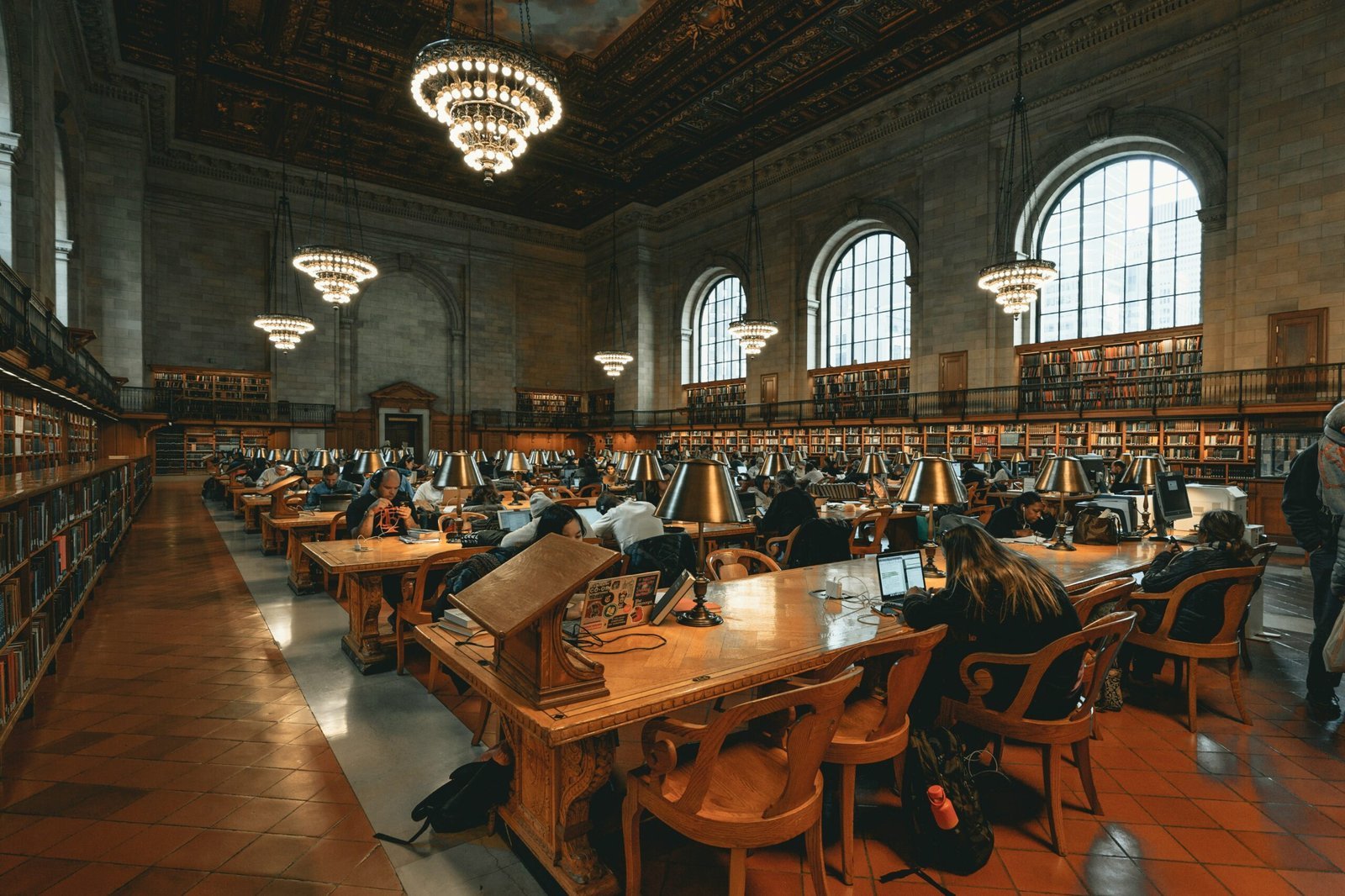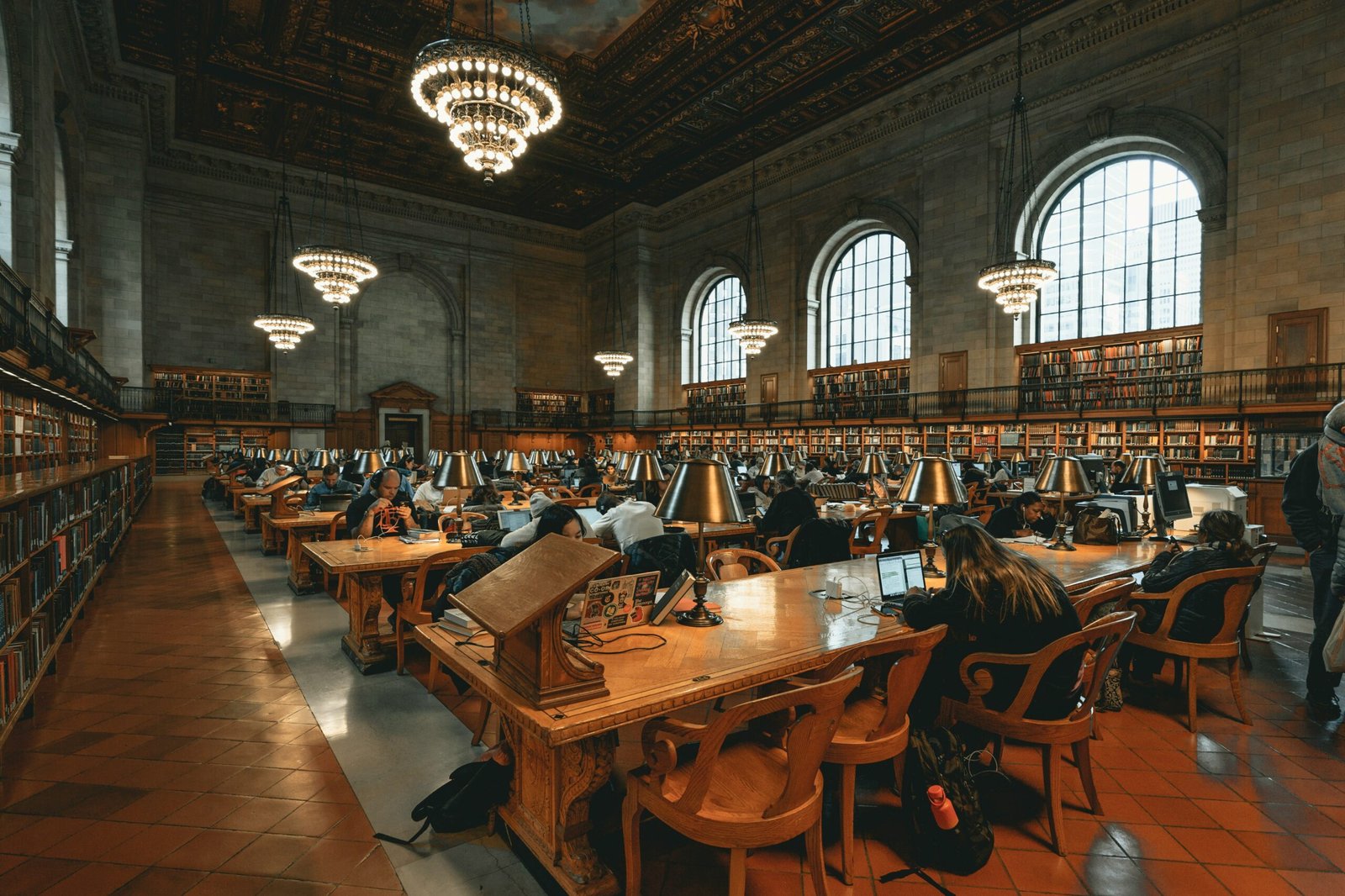The Heart of New York City’s Public Library System

Stephen A. Schwarzman Building
The Stephen A. Schwarzman Building, commonly recognized as the main building of the New York Public Library system, stands as a beacon of knowledge and architectural grandeur in New York City. Situated at Fifth Avenue and 42nd Street, this historic landmark is more than just a library; it is a cultural and intellectual hub that has served millions of patrons since its opening in 1911.
As the largest municipal library in the United States, the Schwarzman Building is renowned for its extensive collections, including rare books, manuscripts, and research materials that span the breadth of human knowledge. Its status as an iconic institution is further cemented by its Beaux-Arts design, featuring grand staircases, majestic reading rooms, and the impressive facade guarded by the famous marble lions, Patience and Fortitude.
The library’s role extends beyond being a repository of books; it functions as a vibrant community space where scholars, students, and visitors from around the world come to explore its vast resources. The Schwarzman Building hosts a variety of public programs, exhibitions, and educational initiatives that contribute to its mission of fostering learning and accessibility.
Through its commitment to preserving history and promoting literacy, the Stephen A. Schwarzman Building has become an indispensable part of New York City’s cultural fabric. It not only provides access to an unparalleled breadth of information but also serves as a testament to the enduring power of public libraries in the digital age. Whether you are embarking on academic research or simply seeking a quiet place to read, the Schwarzman Building offers a unique and enriching experience for all who visit.
Historical Background and Construction
The Stephen A. Schwarzman Building, a cornerstone of New York City’s Public Library System, stands as a testament to early 20th-century architectural ambition and civic dedication. The construction of this iconic structure commenced in 1899, marking the beginning of a monumental project that would span twelve years. The building was finally completed and opened to the public in 1911, embodying the grandeur and vision of its time.
A significant architectural decision that distinguishes the Stephen A. Schwarzman Building is the extensive use of marble. The exterior walls are notably constructed with marble that is 12 inches thick, a choice that underscores both the durability and the aesthetic grandeur of the structure. The use of marble was not merely a stylistic preference but a deliberate strategy to ensure the building’s resilience and longevity. This robust construction has allowed the building to endure the test of time, maintaining its structural integrity and historical charm.
The architects behind this masterpiece, Carrère and Hastings, envisioned a building that would serve as a cultural and intellectual hub for New Yorkers. Their design reflects a Beaux-Arts style, characterized by its monumental scale, classical details, and symmetrical composition. The imposing facade, adorned with Corinthian columns and intricate sculptural elements, speaks to the era’s artistic sensibilities and the city’s commitment to creating a lasting public institution.
In addition to its architectural merits, the construction of the Stephen A. Schwarzman Building represented a significant investment in the city’s cultural infrastructure. The choice of materials, the scale of the project, and the meticulous craftsmanship all contributed to creating a library that was not only functional but also inspirational. Today, the building continues to be a beacon of learning and a symbol of New York City’s dedication to public education and access to knowledge.
Architectural Marvel: Beaux-Arts Style
The Stephen A. Schwarzman Building, an iconic structure within New York City’s Public Library System, stands as a testament to the grandeur of Beaux-Arts architecture. Designed by the esteemed architectural firm Carrère and Hastings, the building’s design draws upon classical influences, showcasing the grandeur and elegance characteristic of the Beaux-Arts style. This architectural marvel, strategically located next to Bryant Park on Fifth Avenue and 42nd Street, serves as both a cultural landmark and a bustling hub for knowledge seekers.
Upon approaching the building, visitors are immediately struck by its imposing façade, which is marked by a series of Corinthian columns that evoke the grandeur of ancient Greek and Roman architecture. The symmetrical design, enriched with intricate sculptural details, exemplifies the Beaux-Arts emphasis on harmony and proportion. The entrance is flanked by the iconic stone lions, Patience and Fortitude, which have become emblematic of the library’s enduring spirit and resilience.
Inside, the opulence continues with a grand marble staircase that ascends to the main reading room, which is one of the largest of its kind. The room’s high ceilings, adorned with elaborate murals and chandeliers, create an awe-inspiring atmosphere that encourages quiet reflection and study. The use of natural light, filtered through large arched windows, adds to the room’s serene ambiance, making it a favored destination for both scholars and casual readers.
Furthermore, the building’s central location in Manhattan enhances its accessibility and prominence. Nestled adjacent to the verdant expanse of Bryant Park, the Stephen A. Schwarzman Building is not just a repository of knowledge but also a serene retreat in the heart of the bustling city. Its proximity to major thoroughfares and public transportation makes it an easily reachable destination for locals and tourists alike, cementing its status as a vital component of New York City’s cultural and intellectual landscape.
The Iconic Lions: Patience and Fortitude
The Stephen A. Schwarzman Building, an integral part of New York City’s Public Library System, is famously guarded by two majestic lion statues named Patience and Fortitude. These iconic figures stand as sentinels at the entrance of the library, embodying the institution’s enduring spirit and its role as a bastion of knowledge and culture.
Patience and Fortitude were named by Mayor Fiorello LaGuardia during the 1930s, a period marked by economic hardship and societal upheaval. LaGuardia believed these virtues were essential for New Yorkers to endure and overcome the challenges of the Great Depression. By christening the lions with such meaningful names, he instilled a sense of resilience and hope in the city’s residents. Today, these statues symbolize the perseverance and strength of the library and its patrons.
Crafted from Tennessee marble by sculptor Edward Clark Potter and the Piccirilli Brothers, the statues were installed in 1911, coinciding with the opening of the library. Over the years, Patience and Fortitude have become more than just architectural adornments; they are beloved landmarks recognized by locals and tourists alike. Their presence is so ingrained in the city’s identity that they have even been featured in various films, literature, and cultural references, further cementing their iconic status.
Beyond their aesthetic appeal, Patience and Fortitude serve a deeper symbolic function. They represent the unwavering commitment of the New York Public Library to provide free access to information and resources to all individuals. The lions remind visitors of the values of intellectual endurance and the courage to seek knowledge, regardless of the obstacles one might face.
In essence, Patience and Fortitude are not just guardians of the library’s entrance but also emblematic of the library’s mission and the enduring spirit of New York City. Their significant presence continues to inspire and welcome millions of visitors each year, making them timeless symbols of the city’s rich cultural heritage.
The Magnificent Rose Reading Room
The Rose Reading Room, one of the most iconic spaces within the Stephen A. Schwarzman Building, is a testament to architectural splendor and artistic grandeur. This majestic room is celebrated for its 52-foot-tall ceilings, which are adorned with intricate gilded skyscapes that evoke the magnificence of a bygone era. These celestial decorations, meticulously crafted, lend an ethereal quality to the room, creating a serene and inspiring atmosphere for all who enter.
The ceiling’s ornate detail is a visual feast that captures the essence of the building’s Beaux-Arts architectural style. The gilded skyscapes, with their delicate hues and shimmering accents, reflect the light in a way that adds warmth and luminosity to the vast room. This interplay of light and art not only enhances the aesthetic appeal but also underscores the importance of the Rose Reading Room as a sanctuary for knowledge and reflection.
Often regarded as one of the most beautiful interior views in the Stephen A. Schwarzman Building, the Rose Reading Room’s design incorporates both functionality and elegance. The spaciousness of the room, coupled with its exquisite detailing, offers a unique environment where scholars, researchers, and visitors can immerse themselves in their work amidst a setting that is both grand and inviting. Long oak tables, lined with classic reading lamps, stretch across the room, providing ample space for study and contemplation.
Beyond its physical beauty, the Rose Reading Room serves as a symbol of the library’s commitment to providing a tranquil and inspiring space for intellectual pursuit. Its design, steeped in history and artistry, continues to captivate the imaginations of all who visit, making it a cornerstone of the New York Public Library system and a cherished landmark in New York City.
Vast Collection and Unique Holdings
The Stephen A. Schwarzman Building, an iconic cornerstone of New York City’s public library system, boasts an expansive and diverse collection that is both formidable and fascinating. Housing over 125 miles of shelved books, the library’s repository includes an astonishing 15 million items. This vast collection is a testament to the institution’s dedication to preserving knowledge, culture, and history from across the globe.
Among the most remarkable holdings are medieval manuscripts that offer a glimpse into the distant past, revealing the intricacies of early written communication and artistry. These ancient texts, painstakingly crafted by hand, are invaluable resources for historians and scholars, providing insight into the societal and cultural contexts of their time.
Equally intriguing are the ancient Japanese scrolls, which illustrate the rich heritage and traditions of Japan. These scrolls, often adorned with exquisite calligraphy and illustrations, serve as cultural artifacts that bridge the gap between ancient and modern worlds. They are a poignant reminder of the enduring legacy of Japanese art and literature.
The library’s collection is not limited to historical documents; it also embraces contemporary literature, housing an extensive array of modern novels. This ensures that the library remains relevant and accessible to today’s readers, offering a broad spectrum of literary works that appeal to diverse tastes and interests. From classic masterpieces to the latest bestsellers, the Schwarzman Building is a treasure trove for book lovers.
In addition to its impressive literary holdings, the library also contains a myriad of other items, including maps, photographs, and artworks. Each piece within this vast repository contributes to the rich tapestry of human knowledge and experience, making the Stephen A. Schwarzman Building an unparalleled resource for researchers, students, and the general public alike.
National Recognition and Historic Significance
The Stephen A. Schwarzman Building, an integral part of New York City’s Public Library System, has garnered national recognition for its architectural grandeur and cultural importance. This iconic structure was designated a National Historic Landmark in 1965, a testament to its enduring significance in the fabric of American history. This prestigious designation is reserved for buildings that possess exceptional value in commemorating or illustrating the history of the United States, and the Schwarzman Building undoubtedly fits this criterion.
Following this accolade, the building was listed on the National Register of Historic Places in 1966. This listing further cemented its status as a vital historical and cultural asset. The National Register is the official federal list of districts, sites, buildings, structures, and objects deemed worthy of preservation for their historical significance. The inclusion of the Schwarzman Building in this list highlights its architectural brilliance and its role as a beacon of knowledge and enlightenment.
The Stephen A. Schwarzman Building stands as a monument to the cultural and intellectual heritage of New York City and the nation. Its Beaux-Arts design, characterized by grandiose facades and intricate detailing, exemplifies the architectural aspirations of the early 20th century. Beyond its aesthetic appeal, the building has served as a crucial hub for research and learning, attracting scholars, students, and visitors from around the world. Its vast collections and resources have made it a cornerstone of public education and cultural enrichment.
The historic significance of the Schwarzman Building extends beyond its physical structure. It represents the democratic ideals of accessible knowledge and the public’s right to information. As a landmark, it continues to inspire awe and admiration, reminding us of the enduring power of libraries in shaping societies and preserving cultural legacies.
Visitor Experience and Cultural Impact
Visitors to the Stephen A. Schwarzman Building can anticipate a multifaceted experience that extends beyond the mere examination of books. Upon entering the iconic library, individuals are greeted by the grandeur of its Beaux-Arts architecture, which sets the tone for an enriching visit. The library offers public tours that provide insight into its history, architecture, and notable collections. These tours are available several times a week, allowing visitors to explore the Rose Main Reading Room, the Periodicals Room, and various other significant spaces.
In addition to tours, the Stephen A. Schwarzman Building hosts a variety of educational programs tailored to different age groups and interests. These programs include lectures, workshops, and exhibitions that cover a broad spectrum of topics, from literary arts to scientific advancements. The Children’s Center provides young visitors with engaging activities and reading sessions, fostering a love for learning from an early age. For adults, the library frequently organizes author talks, panel discussions, and seminars that delve into contemporary issues and literary works.
The library’s role in New York City’s cultural landscape cannot be overstated. It serves as a vital hub for intellectual and cultural exchange, attracting scholars, researchers, and tourists from around the globe. The Stephen A. Schwarzman Building is not just a repository of knowledge but a vibrant community space that promotes cultural enrichment and lifelong learning. Its exhibitions often feature rare manuscripts, historical documents, and artistic works that provide deep insights into various cultures and historical periods.
Moreover, the library actively collaborates with cultural institutions across the city, thereby enhancing its reach and impact. Through partnerships with museums, universities, and art galleries, it contributes to a dynamic cultural ecosystem that benefits both residents and visitors. The Stephen A. Schwarzman Building stands as a testament to the enduring power of public libraries in shaping and sustaining the cultural fabric of New York City.













